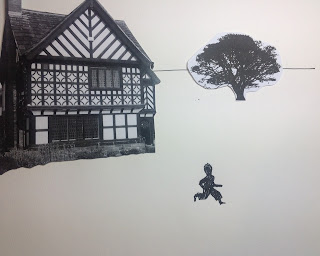What the image says
Two child like figures stumble across the dragon’s lair, where the dragon is found to be asleep. Entwined by the tail of the dragon stands a throne on top of a
pile of gold.
I understand the narrative to be something along the lines of..
A dragon causes a nuisance in the kingdom. Anti-social behaviour
including; Killing knights, arson, disrupting BBQs that sort of stuff. The king
tries to control it using a dragsbo but it makes no difference, so he decides
to bribe the dragon in to good behaviour with riches. The dragon accepts the
gold, but yet again goes back on its word.
Some children take it upon themselves to find the dragon’s lair
and plan to go back and inform the relevant authority or dragon eradication
service DRAG-GONE.
We find our intrepid duo at the mouth of the cave. Ignoring the
parental guidance not to play with fire, the flame of their torch illuminates
the inner cave and there glittering before them are the riches taken under
false pretences. The torch also picks out none other than the sleeping dragon.
Having succeeded in the first part of the plan the children prepare to leave.
 |
| My Mapping sheet |
After several unsatisfactory attempts at direct analysis of the
image. I needed another way to ‘look’ at the composition. I came up with the
idea of mapping the image as above.
Palette, tonal definitions and primary points of focus, marked out
on a piece of transparent layout paper over the Mark Oliver illustration.
I found that doing
this helped my understanding of the underlying tonal and compositional
hierarchy in the picture.
I decided to further analyse the image by treating it as if
setting the scene in a stage play, or its scenography.
To set the scene we have the main ‘set backdrop’ of the cave, with
the cave mouth to the left lit with a cool blue light. The inner cave to the
right, is a warmer deep purple latent heat emitted from a sleeping dragon that
is coiled around a throne and a pile of gold coins.
In the cave mouth are two figures one holds above their heads a
flaming torch. The torch casts a bright hot yellow reflected light in the cave
ceiling directly above, highlighting their presence. Tonally the torch is emitting
a warming influence on the adjacent environment, gradually dissipating through
an orange palette into the cooler mauve and blues towards the back of the cave.
Either side of the entrance are deposited piles of armour and
weapons they absorb some of the warm light from the torch indicated by the
green effect.
The area immediately above the figures has a peculiar textual
quality, as if coated in a congealed liquid or plasma. The torch also
highlights the central focus of the throne.
Although I initially assumed the vivid red dragon was the key element to the scene, after studying the scene and the mapping; I would suggest that the hottest spots in the image, essentially created by the torch, are used to give an indication of the important focal points for this illustration. They point to the actual ‘discovery’ of the throne and gold by the two figures as the key to this illustration and that the dragon is secondary in this particular episode.










